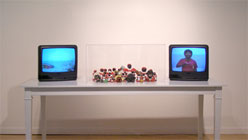In his current exhibition at the Rena Bransten Gallery, Fred Wilson explores the idea that Black is not only beautiful but also philosophical. Wilson is an expert at producing conjunctions of historical objects that expose the racist undertones in the history of art and in material culture. It could be said that no artist has done more than he to bring the dynamics of identity politics into art and history museums throughout the United States and abroad. Wilson’s installations earned him a powerful reputation in the art world during the 1990s and a MacArthur “genius” award in 1999. After twenty years, one might wonder whether his conceptual language has evolved in the ensuing decades. This exhibition presents an artist comfortable with his métier but also one whose approach has expanded beyond the disruption of institutional cultures to include signaling the limits of representing blackness through material culture.
Wilson’s work has been something of a sensation since his project, Mining the Museum, co-organized by The Contemporary Museum in Baltimore, opened at the Maryland Historical Society in 1992. Combining objects from the society’s collection that normally were not seen together into the same vitrine, such as silver coffee-service sets and slave manacles, Wilson launched an understated and irreverent attack upon the racial blind spots of American history. In the Whitney Museum’s Black Male exhibition in 1994, Wilson’s Guarded View (1991) — a group of four headless black mannequins wearing the guard uniforms of various New York City museums — greeted visitors to the exhibition. The work seemed to say: “If you are looking for the representation of African Americans at a canonical museum of American art, look no further than the security staff.”1 More exhibitions followed at art museums around the country, and by the beginning of the twenty-first century, Wilson was given a mid-career retrospective and selected to represent the United States at the 2003 Venice Biennale.

Me and It, 1995; Courtesy of the Artist and Rena Bransten Gallery, San Francisco.
While in Venice, Wilson began working with Murano glassmakers to produce original works in glass; one of these, Goin’ Places (2003), is on view at the Rena Bransten Gallery. This two-part work is composed of a candlestick in the form of a headless figure with black arms and a separate black head with golden hair. The prototype for this work can be found in eighteenth-century blackamoor figures, but Wilson removed the head from the figure and enlarged it, as if the head had expanded beyond its prior confines. Moorish figures such as these are a staple among decorative arts boutiques in Europe just as black jockey figures have long been a common sight in the American South. These days, Wilson is still in the business of repurposing discovered objects in order to set up his classic juxtapositions but with somewhat different aims. Untitled (Zadib, Sokoto, Samori, Veneto, Zanzibar, Dhaka, Macao) (2011), for example, features a plaster blackamoor figure holding aloft an illuminated globe that Wilson has painted black and given black tassels. This chintzy decorative object has been altered to reveal its underlying ugliness. The title gives a clue to the meaning of the tassels; each one marks a location of the Muslim slave trade during the Moorish domination of the Mediterranean basin. The historical object in this case is transformed so that the stylized Moorish servant reveals a history of black dominion and the subordination of others.
One can perceive a new turn in Wilson’s work by comparing two tabletop works on view: Me and It (1995), which Rena Bransten originally presented in 1995, and a more recent work, Love and Loss in the Milky Way (2005). Me and It consists of two video monitors placed on a wide table, on either side of a selection of ceramic vessels depicting stereotyped black figures (think Aunt Jemima) in various poses. In the video, Wilson attempts to replicate the poses of each of these figures while dressed in a similar manner. This presentation of the power of racial imagery and typology that circulates in popular culture demonstrates not only the absurdity of black stereotypes but also the violence they enact upon black individuals.


